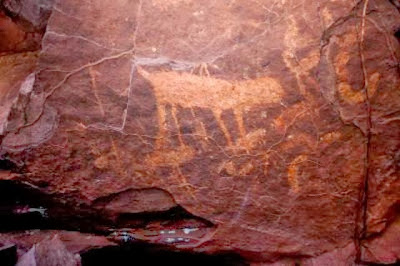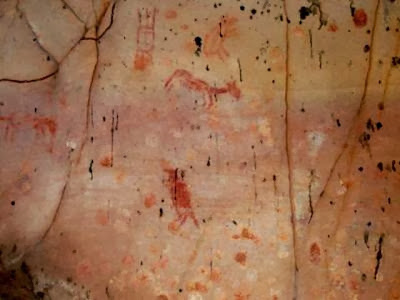Prehistoric cave drawings discovered in Brazil
While tracking white-lipped peccaries and gathering environmental data in forests that link Brazil's Pantanal and Cerrado biomes, a team of researchers from the Wildlife Conservation Society and a local partner NGO, Instituto Quinta do Sol, discovered ancient cave drawings made by hunter-gatherer societies thousands of years ago.
in the journal Revista Clio Arqueológica. The diversity of the renderings, according to the authors, adds significantly to our knowledge of rock art from the Cerrado plateau region that borders the Pantanal.
"Our work with the Wildlife Conservation Society focuses on promoting sustainable land use practices that help protect important wildlife species and the wild places where they live," said Dr. Alexine Keuroghlian, researcher with WCS's Brazil Program. "Since we often work in remote locations, we sometimes make surprising discoveries, in this case, one that appears to be important for our understanding of human cultural history in the region."
Keuroghlian contacted Aguiar, a regional specialist in cave drawings who determined that the drawings were made between 4,000-10,000 years ago by hunter-gatherer societies that either occupied the caves, or used them specifically for their artistic activities. The style of some drawings, Aguiar noted, was consistent with what archeologists call the Planalto (central Brazilian plateau) tradition, while others, surprisingly, were more similar to Nordeste (northeastern Brazil) or Agreste (forest to arid-land transition in NE Brazil) style drawings.
"These discoveries of cave drawings emphasize the importance of protecting the Cerrado and Pantanal ecosystems, both for their cultural and natural heritage," said Dr. Julie Kunen, Director of WCS's Latin America and the Caribbean Program and an expert on Mayan archeology. "We hope to partner with local landowners to protect these cave sites, as well as the forests that surround them, so that the cultural heritage and wildlife depicted in the drawings are preserved for future generations."
Source: Wildlife Conservation Society [November 07, 2013]
in the journal Revista Clio Arqueológica. The diversity of the renderings, according to the authors, adds significantly to our knowledge of rock art from the Cerrado plateau region that borders the Pantanal.
"Our work with the Wildlife Conservation Society focuses on promoting sustainable land use practices that help protect important wildlife species and the wild places where they live," said Dr. Alexine Keuroghlian, researcher with WCS's Brazil Program. "Since we often work in remote locations, we sometimes make surprising discoveries, in this case, one that appears to be important for our understanding of human cultural history in the region."
Keuroghlian contacted Aguiar, a regional specialist in cave drawings who determined that the drawings were made between 4,000-10,000 years ago by hunter-gatherer societies that either occupied the caves, or used them specifically for their artistic activities. The style of some drawings, Aguiar noted, was consistent with what archeologists call the Planalto (central Brazilian plateau) tradition, while others, surprisingly, were more similar to Nordeste (northeastern Brazil) or Agreste (forest to arid-land transition in NE Brazil) style drawings.
"These discoveries of cave drawings emphasize the importance of protecting the Cerrado and Pantanal ecosystems, both for their cultural and natural heritage," said Dr. Julie Kunen, Director of WCS's Latin America and the Caribbean Program and an expert on Mayan archeology. "We hope to partner with local landowners to protect these cave sites, as well as the forests that surround them, so that the cultural heritage and wildlife depicted in the drawings are preserved for future generations."
Source: Wildlife Conservation Society [November 07, 2013]


